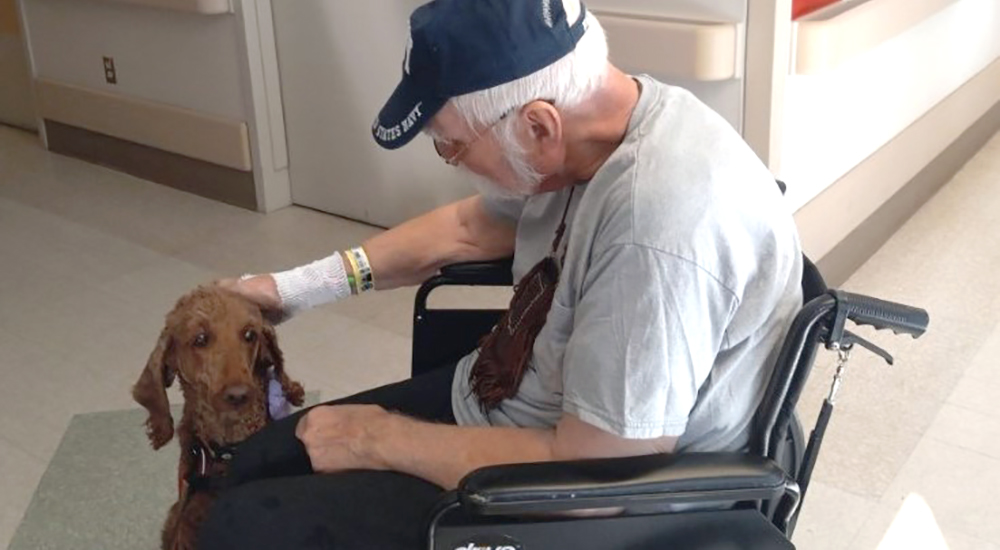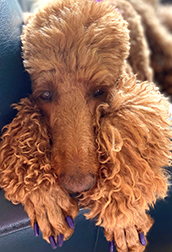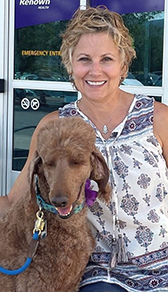Two years ago, beautiful dogs in bright red vests roamed the hallways of the VA Sierra Nevada main campus. It was perfectly natural to see Veterans waiting patiently in the inpatient pharmacy, primary care, mental health and infusion clinic smiling while pleasantly distracted by the fur babies lapping up the attention.
For both animal and human, it was a perfect match.
In the beginning of the pandemic, the halls of our once bustling medical center looked more like a scene out of a post-apocalyptic movie, empty and void of any emotion except fear and sadness.
While medical and administrative staff came together to tackle an unknown scenario while creating lifesaving measures, these animals who aimed to please were kept in their homes with their owners, missing the smiles and personal interaction that made them feel special.
The American Kennel Club even reported that some therapy dogs also struggled with depression.
Alynn Lupold and her husband, Doug, both VA employees, had recently adopted an 8-year-old standard poodle, Aly. Doug is a retired Nevada State Trooper and Air Force Veteran, currently serving as a recreation assistant in the Community Living Center (CLC).
Lupold is a blood and platelet donor and often volunteered at the local food bank. When her husband mentioned how isolated the Veterans felt in the CLC due to COVID and what a benefit it would be to bring therapy animals back, she started her research.
Aly and Ray hit it off immediately
After a year, Lupold and Aly had their first visit on campus. It was worth the wait to see Aly’s magic at work. The first Veteran Aly met with was Navy Veteran Ray. The two hit it off immediately.
“I noticed Aly was more comfortable with Veterans that are seated or in a wheelchair,” Lupold said. “She walked right up to Ray in his wheelchair. You could see Ray relax when she came near him and he used such a sweet tone when talking to her.”
Whispers passed from man to dog as he patiently stroked her head. At one point, Ray stopped petting her to talk to Alynn and recreational therapist Joanne Ferris. Aly was quick to make it clear that she didn’t like being ignored by her new friend. She pushed in closer to Ray and put her head in his lap, demanding more attention.
Ray chuckled. “Do you see this? She’s such a sweetheart!” he said. When asked what he thought about the program returning, Ray said, “She’s a sweetie and brightens my day.”
Stern Veteran no match for friendly poodle
Aly coaxed the softest words from 20 Veterans that day with her abnormally long eyelashes, fancy hairdo, and purple toenails. One Veteran’s reaction caught most of the surrounding witnesses off guard. He was known for having a rather stern personality, but his heart proved no match for Aly’s soft, honey-colored eyes.
Covered from head to toe in tattoos and in his 70’s, Michael had suffered a stroke on his left side and was sitting on his bed when Aly came into his room.
Lupold maneuvered Aly to the left side of the bed so that Michael could see and interact with her. Immediately Aly recognized Michael and jumped up onto his bed, catching everyone off guard.
The older Veteran laughed, teared up and hugged the lovable poodle. It quickly became clear who was in charge as all watched this man’s heart melt with zero shame. “I love Aly and she loves me,” the Veteran said.
Amazing how much Veterans respond
For anyone wondering if their perfect pooch would fit the mold, Alynn advises, “Your dog needs to be well socialized with a calm demeanor, good natured and can’t be timid or afraid. It’s also important that the dog has no aggressive behavior towards other dogs or people as you will be walking around the facility and other people will have their service animals with them.”
When asked if all the Veterans’ smiles made the long certification process worth it, Alynn simply replied, “Without a doubt.”
For more information on certifying your dog as a pet therapy animal, visit Alliance of Therapy Dogs.
Differences between therapy animals and service animals
There are differences between therapy animals and service dogs. It can sometimes be confusing to understand these differences.
- A service animal refers to any dog that is individually trained to do work and perform specific tasks for the benefit of an individual with a disability. The task(s) performed by the dog must be directly related to the person’s disability. Service dogs can be trained to perform many important tasks to assist people with disabilities, such as providing stability for a person who has difficulty walking, picking up items for a person who uses a wheelchair, preventing a child with autism from wandering away, or alerting a person who has hearing loss when someone is approaching from behind.
- Therapy animals are used (usually in a clinical setting) to improve quality of life and improve physical, developmental, social, cognitive and/or emotional health functioning. These assistance animals are not limited to canines and can include animals other than dogs, including cats, horses, llamas and a number of other animals.
The Puppies Assisting Wounded Servicemembers Act of 2021 (PAWS Act of 2021) has been signed into law. It establishes a grant programs program for the purpose of pairing service dogs with eligible Veterans. VA is in the process of developing this grant program.
Topics in this story
More Stories
Study underscores important role COVID vaccination can have in protecting Veterans from infection and reducing long-term health consequences
Columbia VA’s robotic surgery teams completed their 800th robotic surgery and are on schedule to hit 1,000 by the end of the year.
In a decentralized clinical trial, Veterans can participate from their own homes or local VA instead of having to travel to a research site.








